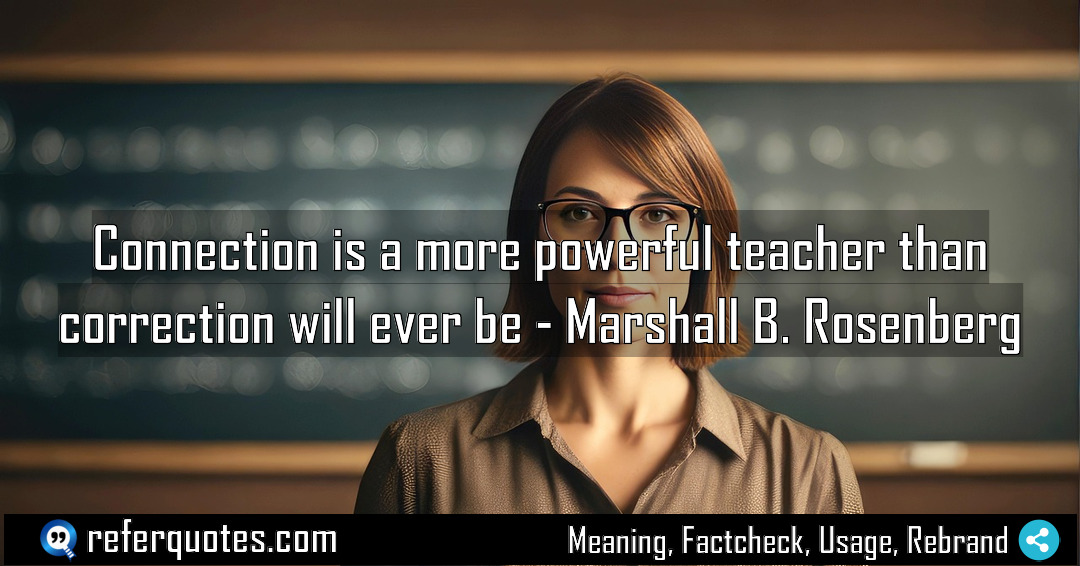
You know, “Connection is a more powerful teacher than correction” gets to the heart of what truly changes behavior. It’s a simple but profound shift from managing actions to nurturing relationships, and it’s a game-changer in how we lead and parent.
Share Image Quote:
Table of Contents
Meaning
At its core, this quote means that the trust and safety of a genuine relationship do more to inspire learning and growth than any punishment, lecture, or pointed criticism ever could.
Explanation
Let me break this down for you. For years, I saw “correction” as my main job—pointing out mistakes, giving the right answer. But that just builds walls. Think about it. When someone corrects you, what’s your first instinct? To get defensive, right? You stop listening. Connection, on the other hand… that’s the fertile ground. When a person, especially a child, feels truly seen and heard by you, they drop their guard. Their mind opens up. They’re not learning to avoid a reprimand; they’re learning because they feel safe and they trust you. The lesson doesn’t just land in their brain; it sinks into their heart. It becomes a part of who they are. It’s the difference between compliance and genuine, lasting change.
Quote Summary
Reading Level60
Aesthetic Score93
Origin & Factcheck
This wisdom comes straight from the work of Marshall B. Rosenberg, the founder of Nonviolent Communication (NVC). It’s from his booklet, “Raising Children Compassionately,” which was published in the United States. You sometimes see similar sentiments floating around, but this specific, powerful phrasing is Rosenberg’s.
Attribution Summary
Where is this quotation located?
| Quotation | Connection is a more powerful teacher than correction will ever be |
| Book Details | Publication Year/Date: 2004; ISBN/Unique Identifier: 9781892005140; Last edition: PuddleDancer Press, 1st Edition, 48 pages. |
| Where is it? | Chapter: The Power of Connection, Approximate page from 2004 edition |
Context
Rosenberg was applying his NVC framework specifically to the parent-child dynamic. He was pushing back against the classic, authoritarian model of parenting where the parent’s role is to control and correct behavior through power. He argued that this power-based dynamic damages the relationship and fails to teach the underlying values we actually care about.
Usage Examples
So how does this look in real life? It’s a shift in your first move.
- For Parents: Instead of snapping, “Stop throwing that ball in the house!” you might get on their level and say, “I see you’re having fun with that ball. I’m worried something might get broken. How about we take it outside, or we can find a softer toy to throw in here?” You’re connecting with their need for play before addressing the rule.
- For Managers: Instead of a critical email about a missed deadline, you pull the team member aside and say, “Hey, I noticed the report was late. I want to make sure you have everything you need to be successful. Is there a bottleneck I can help with?” You connect with their need for support, making the “correction” about collaboration, not failure.
- For Anyone in a Relationship: When your partner is upset, instead of immediately offering solutions (“You should just…”), you connect first. “It sounds like you’re feeling really frustrated about what happened at work. That must have been tough.” The connection makes them feel supported, and often, they’ll find their own solution.
To whom it appeals?
Share This Quote Image & Motivate
Motivation Score88
Popularity Score93
Shareability Score95
Common Questions
Question: Does this mean we should never correct anyone?
Answer: Not at all. It means correction is far more effective *after* a connection has been established. It’s about the order of operations. Connection first, guidance second.
Question: Isn’t this just being permissive and letting people walk all over you?
Answer: That’s a common misunderstanding. This isn’t about being a doormat. It’s about enforcing boundaries *with empathy*. You can be both kind and firm. “I understand you’re angry, and I won’t let you hit me” is a connected boundary.
Question: What if I don’t have time for a long conversation to “connect”?
Answer: Connection doesn’t have to be a 30-minute therapy session. It can be a single sentence that validates the other person’s humanity before you state your need. It’s a shift in tone and intention, not necessarily a huge time investment.
Question: Is this only for children?
Answer: Absolutely not. The principle is universal. It works with employees, spouses, friends… anyone. The human brain is wired to learn and adapt best in a state of psychological safety, which connection provides.
Similar Quotes
When we focus on connection, correction follows naturally. It’s a game-changer that flips traditional discipline on its head. You stop fighting the symptoms and start addressing the root cause. Table…
You know, “Connection, not correction” flips the entire script on traditional parenting. It’s about shifting from being a boss to being a bridge, and honestly, it changes everything once you…
You know, that idea that “Correction without connection feels like rejection” hits so deep. It’s one of those simple truths that changes everything once you get it. Table of Contents…
You know, “Connection before correction builds trust” is one of those principles that seems obvious once you hear it, but it completely flips the script on traditional discipline. It’s not…
When we choose connection over control, we fundamentally shift the parenting dynamic. It’s about moving from a power struggle to a partnership, where love itself becomes the most effective teacher…
